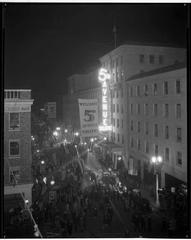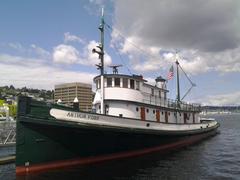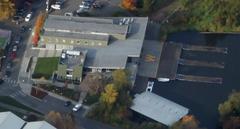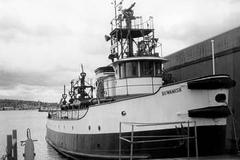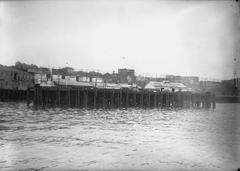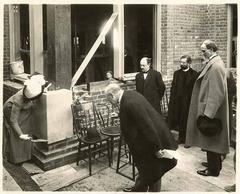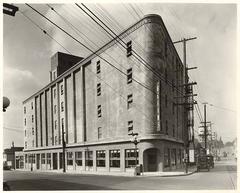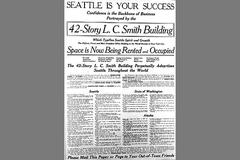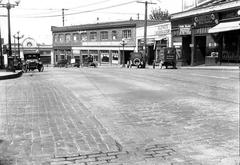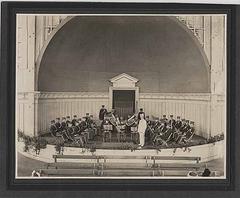Howe Street Stairs Visiting Hours, Tickets, and Seattle Historical Sites Guide
Date: 04/07/2025
Introduction: Discovering Seattle’s Iconic Howe Street Stairs
The Howe Street Stairs serve as a stunning testament to Seattle’s creative adaptation to its famously steep terrain. Built in 1911, this historic stairway connects the Capitol Hill and Eastlake neighborhoods, forming one of the city’s longest continuous stairways with approximately 388 concrete steps spanning nearly four city blocks. What began as a practical solution for pedestrian movement has evolved into a vibrant landmark for fitness, community gatherings, and urban exploration. This guide covers everything you need to know about the Howe Street Stairs, including their history, architectural highlights, visiting hours, accessibility, travel tips, and nearby attractions (Seattle Department of Transportation, Atlas Obscura).
Contents
- Early Development and Urban Context
- Architectural Features and Design
- Historical Significance
- Visitor Information: Hours, Tickets, Accessibility, Travel Tips
- Community and Cultural Impact
- Preservation and Modern Challenges
- Integration with Seattle’s Transportation Network
- Notable Events and Public Perception
- Frequently Asked Questions (FAQ)
- Nearby Attractions and Guided Tours
- Best Photographic Spots
- Conclusion and Call to Action
Early Development and Urban Context
During the late 19th and early 20th centuries, Seattle’s rapid growth and hilly geography demanded inventive solutions for urban mobility. The Howe Street Stairs, completed in 1911, became a critical pedestrian link, connecting neighborhoods divided by steep inclines and providing access to new streetcar lines. As part of a comprehensive stairway-building initiative—resulting in over 650 public stairways citywide—Howe Street’s steps enabled daily commutes, commercial access, and social interaction across neighborhoods (Seattle Department of Transportation).
Architectural Features and Design
The Howe Street Stairs are constructed primarily of reinforced concrete to withstand Seattle’s wet climate. The 388-step staircase is divided into multiple flights, separated by landings that offer rest points and scenic overlooks. Railings, mature trees, and landscaping flank the stairs, creating a green corridor and a welcoming environment for users. The stairway’s alignment capitalizes on the city’s topography, offering occasional views of Lake Union and the surrounding neighborhoods (Atlas Obscura).
Historical Significance
The Howe Street Stairs symbolize Seattle’s commitment to pedestrian-friendly infrastructure and walkability. Originally built to overcome the physical barriers posed by steep hills, these stairs facilitated access to streetcar lines, linking Capitol Hill and Eastlake residents to the broader city. Over the decades, they have adapted to changing urban needs, evolving from a transportation necessity to a recreational and cultural asset (Seattle Stairways Walks).
Visitor Information: Hours, Tickets, Accessibility, and Travel Tips
Visiting Hours and Admission
- Open: 24 hours a day, 7 days a week
- Admission: Free; no tickets required
Accessibility
- Mobility: The stairs are not wheelchair accessible due to their steep incline and number of steps.
- Alternatives: Nearby parks, such as Volunteer Park, offer accessible paths and amenities.
Getting There
- Public Transit: Served by multiple Metro bus routes and close to the Capitol Hill light rail station (King County Metro).
- Parking: Limited street parking is available; public transit or rideshare is recommended.
Travel Tips
- Wear comfortable shoes and bring water.
- Visit early morning or late afternoon for cooler temperatures and fewer crowds.
- Use handrails and be cautious, especially in wet conditions.
- Combine your visit with nearby attractions for a richer experience.
Community and Cultural Impact
The Howe Street Stairs are more than a set of steps—they are a community landmark. Regularly used for fitness by individuals and groups, they also host charity runs, organized stair climbs, and neighborhood events. Local residents and advocacy groups organize periodic clean-ups and safety improvements, enhancing the stairway’s appeal. Public art and seasonal decorations further embed the stairs in the city’s cultural landscape (Seattle Times).
Preservation and Modern Challenges
Maintained by the Seattle Department of Transportation, the stairs’ preservation is a priority for the city’s historic infrastructure program. Challenges include exposure to noise and pollution from nearby I-5, as well as occasional safety concerns. Community efforts focus on improving lighting, increasing patrols, and advocating for additional safety features (Seattle DOT Stairway Maintenance).
Integration with Seattle’s Transportation Network
Strategically located near Eastlake Avenue and the I-5 corridor, the stairs historically provided access to streetcar lines and now facilitate connections to bus and light rail services. This integration supports Seattle’s multimodal transportation goals, making the Howe Street Stairs a vital link for pedestrians and cyclists navigating between Capitol Hill, Eastlake, and South Lake Union (King County Metro).
Notable Events and Public Perception
The stairs are a favorite for fitness enthusiasts, marathon trainers, and community groups. They are frequently featured in local guidebooks and media as one of Seattle’s best outdoor workout locations. Community-driven efforts, such as neighborhood watch programs and public art installations, contribute to the stairs’ positive public image (Atlas Obscura).
Frequently Asked Questions (FAQ)
Q: What are the visiting hours?
A: The stairs are open 24/7, year-round.
Q: Is there an admission fee or tickets required?
A: No, the stairs are free and open to the public.
Q: Are the stairs wheelchair accessible?
A: No, but accessible parks are nearby.
Q: How can I get there by public transportation?
A: Use Metro bus routes or the Capitol Hill light rail station.
Q: Are the stairs safe?
A: Generally safe during daylight hours; exercise caution at night and be aware of your surroundings.
Q: Can I bring my dog?
A: Yes, dogs are allowed but should be kept on a leash.
Nearby Attractions and Guided Tours
- Volunteer Park: Features the Seattle Asian Art Museum and scenic viewpoints.
- Streissguth Gardens: Serene public gardens adjacent to the stairs.
- Lake Union: Ideal for waterfront strolls and water activities.
- Blaine Street Stairs: Another impressive stairway, often combined with Howe Street for urban hikes.
Several local tour companies include the Howe Street Stairs in walking tours focused on Seattle’s stairways and historical neighborhoods.
Best Photographic Spots
- Capture panoramic views of Lake Union from higher landings.
- Early morning and late afternoon offer the best lighting.
- Lush landscaping and seasonal blooms provide colorful backdrops.
Ensure all images include descriptive alt text, such as “Howe Street Stairs Seattle historical site” and “Howe Street Stairs visiting hours.”
Conclusion and Call to Action
The Howe Street Stairs are a remarkable fusion of Seattle’s history, urban design, and community vitality. Open year-round and free to access, they offer a rewarding destination for fitness, sightseeing, and connecting with local culture. Plan your visit to experience this unique urban landmark—bring comfortable footwear, take advantage of Seattle’s transit, and explore nearby attractions for a full day of discovery.
For more curated guides and real-time updates on Seattle’s best stairways and historical sites, download the Audiala app and follow us on social media. Stay informed about special events, community initiatives, and new walking tour features centered around the Howe Street Stairs.
Sources
- Seattle Department of Transportation Stairway Maintenance Program
- Atlas Obscura – Howe Street Stairs
- Seattle Stairways Walks
- King County Metro
- Seattle Times – Seattle’s Stairways Are a Great Way to Get Outside and Get Fit
- Seattle Times – The Steps Really Add Up at Seattle’s Longest Flight of Public Stairs
- Seattle Department of Neighborhoods – Historic Preservation
